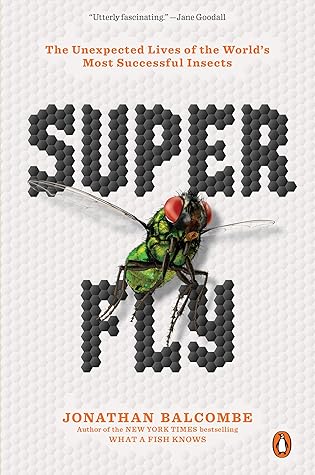Kindle Notes & Highlights
Read between
October 11 - November 10, 2022
the arrangement of facets on the large eyes of some horseflies and deerflies creates psychedelic patterns of light
and color.
The use of bristle arrangement for identification is important enough to have a name: chaetotaxy (KEY-toe-tax-y).
can hover, fly backward, and land upside down.
If you’ve spent time handling beetles, you’ll have noticed their common reluctance to take flight, in contrast to the hyper-aerial flies.
insects were flying 150 million years before any other creature was.
A housefly attains 345 beats per second; a mosquito up to 700 beats; and a tiny biting midge, a startling 1,046 beats.
Life in the Undergrowth,
The study of fly flight is an active field, with applications to physics, energetics, and robotics.
shieldlike plate, the scutellum, connects the two wings, while another plate, the subepimeral ridge (a bump on the lower side of a fly’s thorax), connects each wing to its respective haltere.
Our system of balance is in our ears. Not so a fly’s. Flies balance and steer using their halteres, those remnants of wing pair number two
flapping at the same rate but usually precisely antiphase to the wings.
some flies lack wings altogether.
a pair or trio of pads on each foot, called pulvilli.
From each pad sprouts thousands of tubes, each of which terminates in a very smooth, flat pad. Once thought to work by suction, pulvilli work by adhesion.
The fly walks by altering the angle of the foot pads to release the hold.
The base of each follicle is innervated, rendering the fly sensitive to minute changes in airflow.
700 beats per second,
marmalade hoverfly, millions of which zoom over the Swiss Alps twice yearly on their round trip from northern to southern Europe.
With a tailwind they ride high; with a headwind they scoot low.
For flying organisms, visual fields change quickly, so—with the exception of echolocating bats—strong vision is crucial.
This arrangement implies that what an insect sees is a mosaic of small images knitted together.
it is now generally accepted that insect brains integrate the separate signals from each ommatidium into one seamless whole, just as our brain melds the images from our two eyes into one.
motion parallax.
Three ocelli, light-sensitive organs on the top of the head and totally separate from the eyes, detect changes in light intensity, helping the fly to react swiftly to the approach of an object.
Flying blowflies, for example, shift their gaze by rapid, discrete turns (saccades) of the body and head, keeping their gaze basically fixed between each saccade.
fruit flies, each of whose eyes has a modest 600 or so facets, have shown that they use a visual prioritizing system. Things that are static are kept blurry, while anything moving, independent of the visual changes caused by the fly’s own movements, is brought into sharp focus.
the males of many flies tend to have larger eyes that meet at the midline.
holoptic eyes
Female flies, with few exceptions, have dichoptic eyes, which do not meet.
flies’ taste receptors are mounted on bristles scattered all over the body, including legs, wings, and the egg-laying ovipositor.
the soft footpads of flies contain taste organs.
But this ability lets a fly sample the nutritional potential of a ripe banana, an arm, or a tabletop the instant it alights on its surface.
through those same channels, saliva can be drizzled on the substrate, helping dissolve solid items into a suckable form.
This spongy lower lip of most flies allows them to first liquefy then imbibe sweet or otherwise attractive foodstuffs, such as dried honeydew spattered on a leaf surface by plant-sucking bugs.
Today’s flies are 100 times as sensitive to the taste of sugar as we are.
potential food item must pass two taste tests before a fly will partake.
flies’ sense of taste appears to be similar to ours.
fruit flies have receptors devoted to sweet and bitter tastes just like humans.
Flies smell with their antennae.
Some carrion flies can detect a rotting carcass from at least ten miles.
human scent is made up of 300 to 500 chemical components.
Flies’ versatile antennae have a further sensory use: hearing.
Hearing in flies is usually reserved for courtship,
Alkali flies
Trying to ascertain consciousness in another being has been described as “the hard problem” in the life sciences by influential Australian philosopher David Chalmers.
seemingly intelligent behaviors may occur without conscious awareness.
overwintering strategy of a fly called the goldenrod gallfly.


